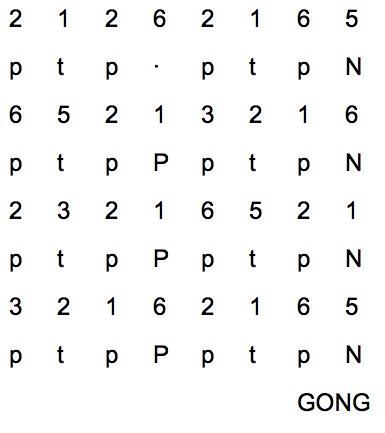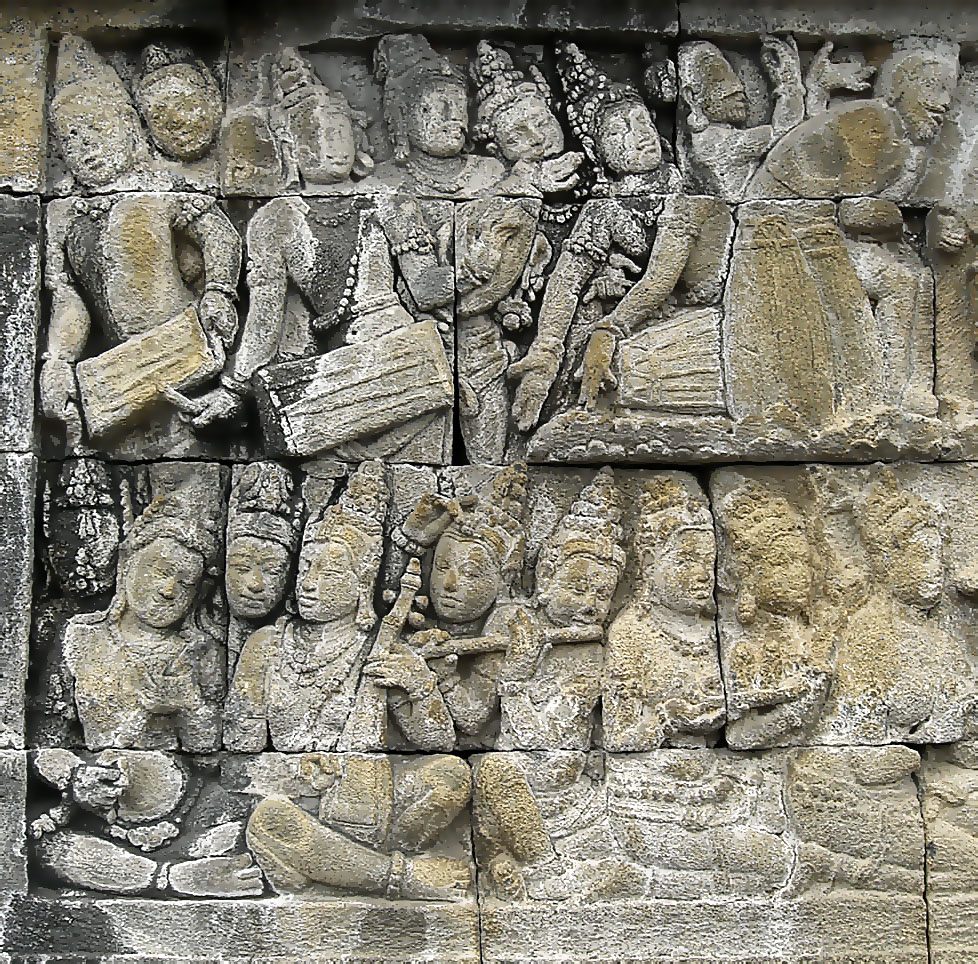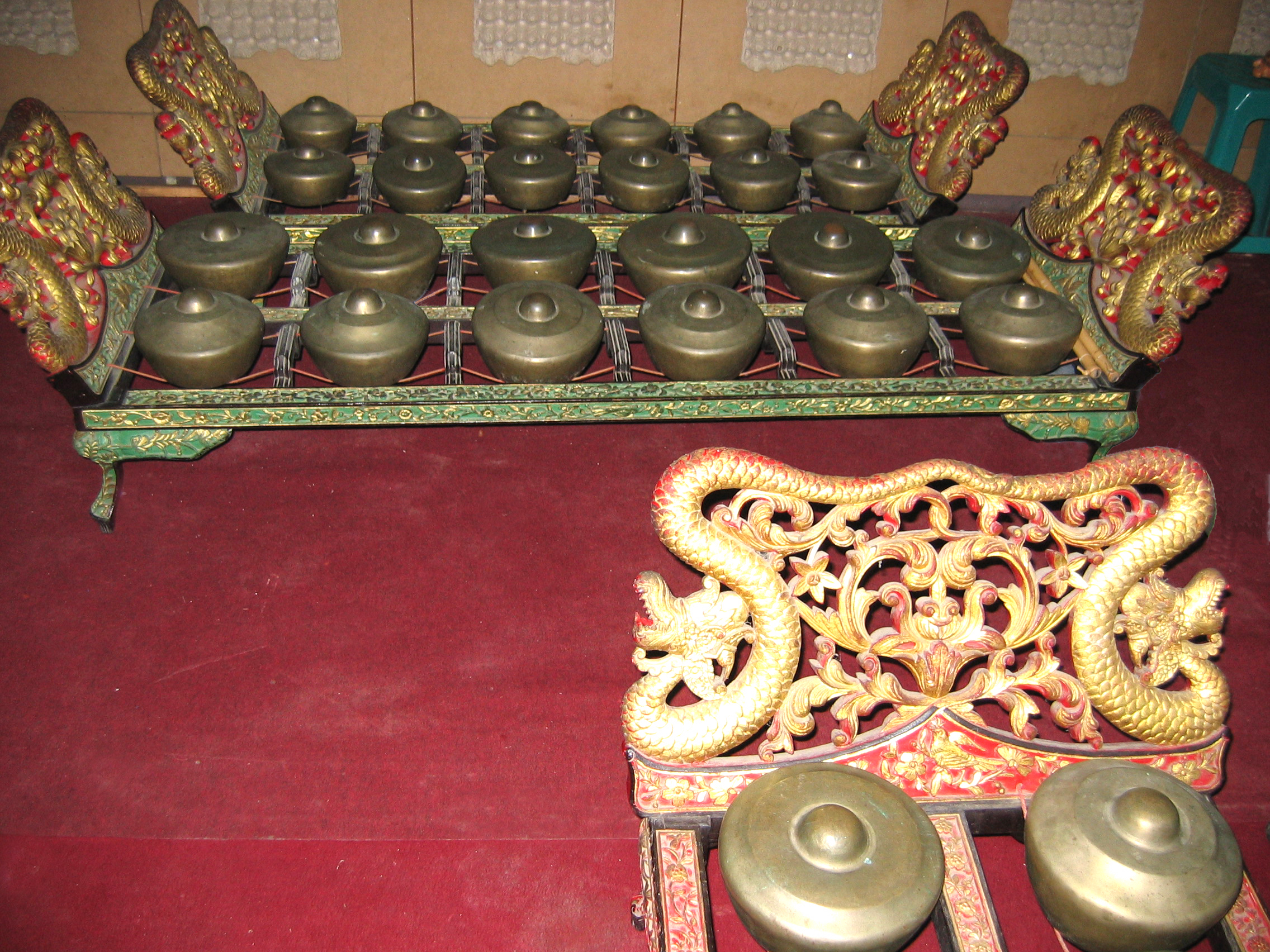|
Kempyang And Ketuk
The kempyang and ketuk are two instruments in the gamelan ensemble of Indonesia, generally played by the same player, and sometimes played by the same player as the kenong. They are important beat-keepers in the colotomic structure of the gamelan. Depending on the structure, they play different, repeating patterns every gongan. Not all structures use the kempyang, but the kempyang is never played without the ketuk. They are shaped like bonang, but are generally placed in their own frame (''rancak''). The kempyang is pitched higher (about one octave, although it depends if they are in the pelog or slendro set. Both have a central boss like the bonang, but the kempyang has a rounder top (like the higher bonangs), while the ketuk has a flat top (like the lower bonangs). In the common numerical notation, kempyang strokes are marked by "-" while the ketuk is marked by "+". The ketuk pattern is used to classify longer gendhing types, where it refers to the number of ketuk strokes i ... [...More Info...] [...Related Items...] OR: [Wikipedia] [Google] [Baidu] |
Percussion Instrument
A percussion instrument is a musical instrument that is sounded by being struck or scraped by a beater including attached or enclosed beaters or rattles struck, scraped or rubbed by hand or struck against another similar instrument. Excluding zoomusicological instruments and the human voice, the percussion family is believed to include the oldest musical instruments.''The Oxford Companion to Music'', 10th edition, p.775, In spite of being a very common term to designate instruments, and to relate them to their players, the percussionists, percussion is not a systematic classificatory category of instruments, as described by the scientific field of organology. It is shown below that percussion instruments may belong to the organological classes of ideophone, membranophone, aerophone and cordophone. The percussion section of an orchestra most commonly contains instruments such as the timpani, snare drum, bass drum, tambourine, belonging to the membranophones, and ... [...More Info...] [...Related Items...] OR: [Wikipedia] [Google] [Baidu] |
Pelog
Pelog ( su, ᮕᮦᮜᮧᮌ᮪, translit=Pélog /pelog/, jv, ꦥꦺꦭꦺꦴꦒ꧀, ban, ᬧᬾᬮᭀᬕ᭄, translit=Pélog /pelok/) is one of the essential tuning systems used in gamelan instruments that has heptatonic scale. The other, older, scale commonly used is called '' slendro''. ''Pelog'' has seven notes, but many gamelan ensembles only have keys for five of the pitches. Even in ensembles that have all seven notes, many pieces only use a subset of five notes, sometimes the additional 4th tone is also used in a piece like western accidentals. Etymology Pelog is a Javanese term for one of the scales in gamelan. In Javanese, the term is said to be a variant of the word ''pelag'' meaning "fine" or "beautiful". Tuning Since the tuning varies so widely from island to island, village to village, and even among ''gamelan'', it is difficult to characterize in terms of intervals. One rough approximation expresses the seven pitches of Central Javanese ''pelog'' as a subs ... [...More Info...] [...Related Items...] OR: [Wikipedia] [Google] [Baidu] |
Colotomic Instruments
''Colotomy'' is an Indonesian description of the rhythmic and metric patterns of gamelan music. It refers to the use of specific instruments to mark off nested time intervals, or the process of dividing rhythmic time into such nested cycles. In the gamelan, this is usually done by gongs of various size: the ''kempyang'', '' ketuk'', '' kempul'', ''kenong'', ''gong suwukan'', and '' gong ageng''. The fast-playing instruments, ''kempyang and ketuk'', keep a regular beat. The larger gongs group together these hits into larger groupings, playing once per each grouping. The largest gong, the '' gong ageng'', represents the largest time cycle and generally indicates that that section will be repeated, or the piece will move on to a new section. The details of the rhythmic patterns depend on the colotomic structure ( jv, italic=yes, bentuk), also known as ''gendhing'' structure. There are a number of different structures, which differ greatly in length and complexity; however, all of ... [...More Info...] [...Related Items...] OR: [Wikipedia] [Google] [Baidu] |
Music Of Java
The Music of Java embraces a wide variety of styles, both traditional and contemporary, reflecting the diversity of the island and its lengthy history. Apart from traditional forms that maintain connections to musical styles many centuries old, there are also many unique styles and conventions which combine elements from many other regional influences, including those of neighbouring Asian cultures and European colonial forms. Gamelan The gamelan orchestra, based on metallic idiophones and drums, is perhaps the form which is most readily identified as being distinctly "Javanese" by outsiders. In various forms, it is ubiquitous to Southeast Asia. In Java, the full gamelan also adds a bowed string instrument (the rebab, a name illustrative of Islamic influence), plucked siter, vertical flute suling and voices. The rebab is one of the main melodic instruments of the ensemble, together with the metallophone gendér; these and the kendang drums are often played by the most experie ... [...More Info...] [...Related Items...] OR: [Wikipedia] [Google] [Baidu] |
Music Of Indonesia
As it is a country with many different tribes and ethnic groups, the music of Indonesia ( id, Musik Indonesia) itself is also very diverse, coming in hundreds of different forms and styles. Every region have its own culture and art, and as a result traditional music from area to area also uniquely differs from one another. For example, each traditional music are often accompanied by their very own dance and theatre. Contemporary music scene have also been heavily shaped by various foreign influences, such as America, Britain, Japan, Korea, and India. The music of Java, Sumatra, Bali, Flores (Lesser Sunda Islands) and other islands have been well documented and recorded, and further research by Indonesian and international scholars is also ongoing. The music in Indonesia predates historical records, various Native Indonesian tribes often incorporate chants and songs accompanied with musical instruments in their rituals. The contemporary music of Indonesia today is also popula ... [...More Info...] [...Related Items...] OR: [Wikipedia] [Google] [Baidu] |
Kempul
A kempul is a type of hanging gong used in Indonesian gamelan. The kempul is a set of pitched, hanging, knobbed gongs, often made of bronze, wood, and cords. Ranging from 19 cm to 25,4 cm (7 to 10 inches) in diameter, the kempul gong has a flat surface with a protruding knob at the center and is played by hitting the knob with the "soft end of a mallet." "The wooden mallet used has a ball shape head with heavy padding on a short wooden handle. The number of kempul gongs present in a gamelan ensemble varies but, "although there can be two to ten kempul on one separate rack, it is common to have five kempul hanging on the same rack as the Gong ageng and gong siyem" (two larger gongs). Kempul in music "Generally, the instruments in a gamelan orchestra may fall into the following three functional categories: # Instruments that delineate the structure of the piece; # Instruments that guide temporal flow of the music; # Instruments that carry melodies in both simple and ... [...More Info...] [...Related Items...] OR: [Wikipedia] [Google] [Baidu] |
Bonang
The bonang is an Indonesian musical instrument used in the Javanese gamelan. It is a collection of small gongs (sometimes called "kettles" or "pots") placed horizontally onto strings in a wooden frame (''rancak''), either one or two rows wide. All of the kettles have a central boss, but around it the lower-pitched ones have a flattened head, while the higher ones have an arched one. Each is tuned to a specific pitch in the appropriate scale; thus there are different bonang for pelog and slendro. They are typically hit with padded sticks (''tabuh''). This is similar to the other cradled gongs in the gamelan, the kethuk, kempyang, and kenong. Bonang may be made of forged bronze, welded and cold-hammered iron, or a combination of metals. In addition to the gong-shaped form of kettles, economical bonang made of hammered iron or brass plates with raised bosses are often found in village gamelan, in Suriname-style gamelan, and in some American gamelan. In central Javanese gamelan th ... [...More Info...] [...Related Items...] OR: [Wikipedia] [Google] [Baidu] |
Gamelan
Gamelan () ( jv, ꦒꦩꦼꦭꦤ꧀, su, ᮌᮙᮨᮜᮔ᮪, ban, ᬕᬫᭂᬮᬦ᭄) is the traditional ensemble music of the Javanese, Sundanese, and Balinese peoples of Indonesia, made up predominantly of percussive instruments. The most common instruments used are metallophones played by mallets and a set of hand-played drums called '' kendhang/Kendang'', which register the beat. The kemanak (a banana-shaped idiophone) and gangsa (another metallophone) are commonly used gamelan instruments in Bali. Other instruments include xylophones, bamboo flutes, a bowed instrument called a ''rebab'', a zither-like instrument ''siter'' (in Javanese ensemble) and vocalists named '' sindhen'' (female) or ''gerong'' (male).Sumarsam (1998)''Introduction to Javanese Gamelan'' Middletown. Although the popularity of gamelan has declined since the introduction of pop music, gamelan is still commonly played in many traditional ceremonies and other modern activities in Indonesia, b ... [...More Info...] [...Related Items...] OR: [Wikipedia] [Google] [Baidu] |
Gendhing
''Colotomy'' is an Indonesian description of the rhythmic and metric patterns of gamelan music. It refers to the use of specific instruments to mark off nested time intervals, or the process of dividing rhythmic time into such nested cycles. In the gamelan, this is usually done by gongs of various size: the '' kempyang'', ''ketuk'', '' kempul'', ''kenong'', ''gong suwukan'', and '' gong ageng''. The fast-playing instruments, '' kempyang and ketuk'', keep a regular beat. The larger gongs group together these hits into larger groupings, playing once per each grouping. The largest gong, the '' gong ageng'', represents the largest time cycle and generally indicates that that section will be repeated, or the piece will move on to a new section. The details of the rhythmic patterns depend on the colotomic structure ( jv, italic=yes, bentuk), also known as ''gendhing'' structure. There are a number of different structures, which differ greatly in length and complexity; however, all o ... [...More Info...] [...Related Items...] OR: [Wikipedia] [Google] [Baidu] |
Slendro
Slendro ( jv, ꦱ꧀ꦭꦺꦤ꧀ꦢꦿꦺꦴ, ban, slendro, translit=Sléndro) ( su, salendro, translit=Saléndro) is one of the essential tuning systems used in gamelan instruments that have pentatonic scale. Based on Javanese mythology, the Slendro Gamelan tuning system is older than the '' pélog'' tuning system. Etymology Slendro is a Javanese term for one of the scales in gamelan. It is derived either from "Sailendra", the name of the ruling family in the eighth and ninth centuries when Borobudur was built, or from its earlier being given by the god Sang Hyang Hendra. History The origin of the ''slendro'' scale is unknown. However the name ''slendro'' is derived from Sailendra, the ancient dynasty of Mataram Kingdom in Central Java, and also Srivijaya. The ''slendro'' scale is thought to be brought to Srivijaya by Mahayana Buddhists from Gandhara of India, via Nalanda and Srivijaya from there to Java and Bali. It is similar to scales used in Indian and Chinese musi ... [...More Info...] [...Related Items...] OR: [Wikipedia] [Google] [Baidu] |
Octave
In music, an octave ( la, octavus: eighth) or perfect octave (sometimes called the diapason) is the interval between one musical pitch and another with double its frequency. The octave relationship is a natural phenomenon that has been referred to as the "basic miracle of music," the use of which is "common in most musical systems." The interval between the first and second harmonics of the harmonic series is an octave. In Western music notation, notes separated by an octave (or multiple octaves) have the same name and are of the same pitch class. To emphasize that it is one of the perfect intervals (including unison, perfect fourth, and perfect fifth), the octave is designated P8. Other interval qualities are also possible, though rare. The octave above or below an indicated note is sometimes abbreviated ''8a'' or ''8va'' ( it, all'ottava), ''8va bassa'' ( it, all'ottava bassa, sometimes also ''8vb''), or simply ''8'' for the octave in the direction indicated by pl ... [...More Info...] [...Related Items...] OR: [Wikipedia] [Google] [Baidu] |
Idiophone
An idiophone is any musical instrument that creates sound primarily by the vibration of the instrument itself, without the use of air flow (as with aerophones), strings (chordophones), membranes (membranophones) or electricity ( electrophones). It is the first of the four main divisions in the original Hornbostel–Sachs system of musical instrument classification (see List of idiophones by Hornbostel–Sachs number). The early classification of Victor-Charles Mahillon called this group of instruments ''autophones''. The most common are struck idiophones, or concussion idiophones, which are made to vibrate by being struck, either directly with a stick or hand (like the wood block, singing bowl, steel tongue drum, triangle or marimba) or indirectly, with scraping or shaking motions (like maracas or flexatone). Various types of bells fall into both categories. A common plucked idiophone is the Jew's harp. According to Sachs, idiophones Etymology The word is from Anci ... [...More Info...] [...Related Items...] OR: [Wikipedia] [Google] [Baidu] |






